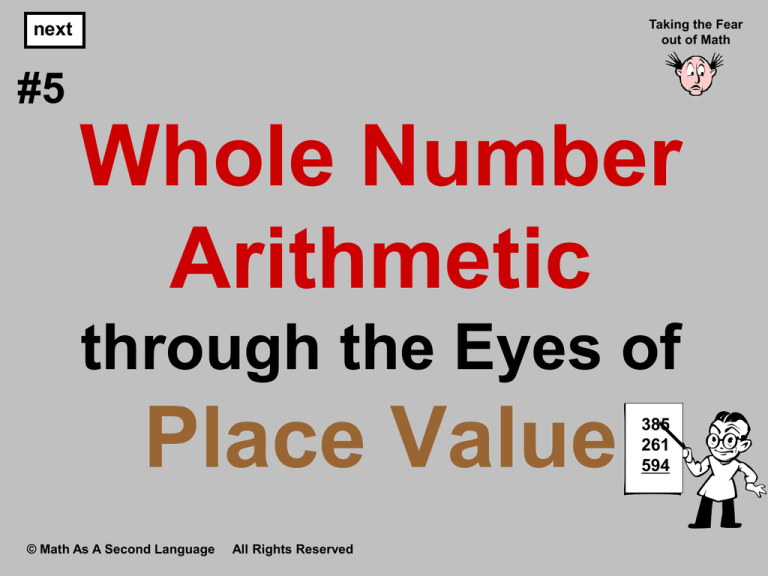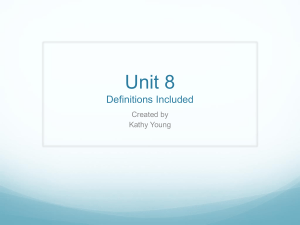
Taking the Fear
out of Math
next
#5
Whole Number
Arithmetic
through the Eyes of
Place Value
© Math As A Second Language
All Rights Reserved
385
261
594
next
Preamble and Review
Until now we have been using tally marks
and/or tiles as our “manipulative” for
explaining the operations that are used in
the arithmetic of whole numbers.
However, as the numbers we use become
greater and greater, the use of
tally marks becomes, at best,
cumbersome and, at worst, “impossible”.
© Math As A Second Language
All Rights Reserved
next
For example, by today’s standards it is
not uncommon to talk about millions,
billions, and even trillions, and yet have no
idea of the magnitude of these numbers.
►A million seconds is about 12 days, but
a billion seconds is about 31 years.
People will often confuse a million and
a billion, but they will never confuse
12 days with 31 years.
© Math As A Second Language
All Rights Reserved
next
In a similar way the word “trillion” gives
us no sense of how large a number it
represents. Note that a trillion is
1,000 billion.
► If a billion seconds is around 31 years,
a trillion seconds is about 31,000 years!
Hence, if we were restricted to using tally
marks and we could write 1 tally mark per
second, it would take around 31,000 years
just to write this number, and around
155,000 years to write 5 trillion tally marks.
© Math As A Second Language
All Rights Reserved
next
So even though when we express a
trillion in place value notation we sense that
1,000,000,000,000 is a very large number,
we often have no idea of just how large.
However, if our goal was to use tally marks
to compute the sum…
3,000,000,000,000 + 2,000,000,000,000,
and we were restricted to being able to
write 1 tally mark per second continuously,
it would take over 155,000 years to find the
answer to this problem!
© Math As A Second Language
All Rights Reserved
next
Even if we replaced the tally mark
method by the abacus, the abacus would
have to have 13 columns in order for us to
be able to represent these numbers
in place value notation.
© Math As A Second Language
All Rights Reserved
next
However, our adjective/noun theme,
together with the properties of arithmetic
that we have discussed previously, used in
conjunction with place value, allow us to
deal with large numbers quite conveniently.
Our “adjective/noun” theme is based
on the following three “rules”.
© Math As A Second Language
All Rights Reserved
next
Rule #1
When we say that two numbers are equal,
we assume that as adjectives1
they are modifying the same noun.
note
1
We must be careful here to emphasize that we don’t have to view numbers as
adjectives. In fact, depending on our point of view a number can be both an
adjective and a noun. For example, on the number line 3 names the point on
the line that is 3 units to the right of 0. In this context, 3 is a noun because it is
the name of a point on the number line. On the other hand, the point 3 is
located 3 units to the right of 0. In that context, 3 is an adjective modifying the
noun “units”.
© Math As A Second Language
All Rights Reserved
next
Rule #1
For example, 12 inches = 1 foot but 12 ≠ 1.
In a similar way 1 = 1 but 1 inch ≠ 1 foot.
This rather simple sounding rule will play
a major role later in such topics
as ratios and proportions.
© Math As A Second Language
All Rights Reserved
next
Rule #2
The “usual” addition facts apply only when
the numbers modify the same noun.
In other words, when we say that 3 + 2 = 5
we assume that 3 and 2 are modifying the
same noun.
For example…
3 dimes + 2 dimes = 5 dimes
3 nickels + 2 nickels = 5 nickels
3 dimes + 2 nickels = 40 cents
© Math As A Second Language
All Rights Reserved
next
Rule #3
When we multiply numbers, we multiply the
two adjectives to obtain the adjective part of
the product, and we multiply the two nouns
to obtain the noun part of the product.
In other words, 3 × 2 = 6, regardless of
what nouns 3 and 2 are modifying.
However, what the 6 modifies depends on
what the 3 and the 2 modify.
© Math As A Second Language
All Rights Reserved
next
Rule #3
For example…
3 miles per hour2 × 2 hours = 6 miles
3 hundred × 2 thousand = 6 hundred thousand3
note
in this case 3 is modifying the noun phrase miles per hour”. When we talk
about the adjective/noun theme, the noun can be a noun phrase.
For example, when we write 600,000 we may think of 6 as modifying hundred
(in which case, 600 is modifying thousands) or we may think of 6 as
modifying the noun phrase “hundred thousand”.
2 Actually
note
3
When the nouns occur as words, we multiply them by writing them side by side.
Thus, for example, hundred × thousand = hundred thousand.
And if we multiply 2 inches by 5 feet, the answer is 10 inch feet.
© Math As A Second Language
All Rights Reserved
next
And the rules (properties) of arithmetic
that we have discussed so far are…
Rule #1 The Closure Property
If b and c are whole numbers, then b + c
and b × c are also whole numbers.
Rule #2 The Commutative Property
If b and c are whole numbers, then
b + c = c + b and b × c = c × b.
© Math As A Second Language
All Rights Reserved
next
Rule #3 The Associative Property
If b, c, and d are whole numbers, then
(b + c) + d = b + (c + d), and
(b × c) × d and b × (c × d).
Rule #4 The Distributive Property
If b, c, and d are whole numbers, then
b × (c + d) = (b × c) + (b × d).
© Math As A Second Language
All Rights Reserved
next
addition
© Math As A Second Language
393
265
895
With the above rules as
our prerequisite
information, we will
now look at whole
number arithmetic
through the eyes of
place value.
All Rights Reserved










